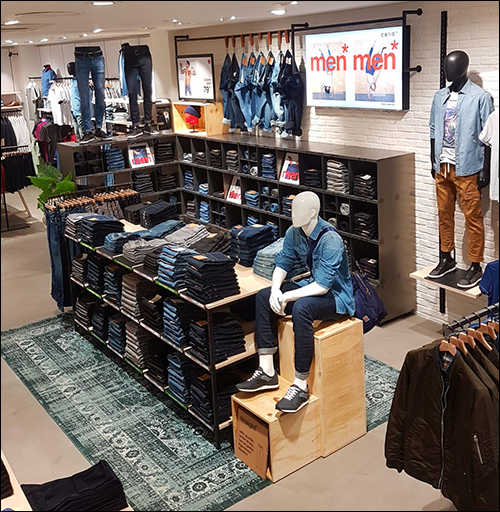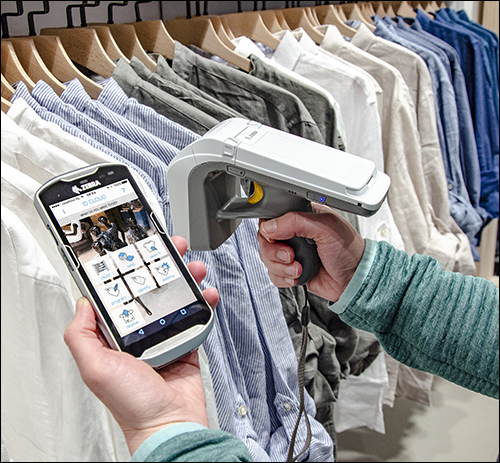In one of France’s largest UHF RFID implementations, menswear retailer Celio has deployed RFID technology across all 750 of its stores. The system’s rollout was completed in November 2017, following a 12-month deployment period, and is bringing visibility to inventory at each location. RFID was taken live at the point of sale (POS), along with electronic article surveillance (EAS) technology, at 55 of those locations by the end of 2018.
With the technology, provided by Nedap, Celio reports that it will be able to provide fast and accurate e-commerce service to its online customers, as well as prevent out-of-stocks and reduce clerical work that is otherwise needed to understand where goods are located. With the POS and EAS systems, the store can gain real-time understanding of which goods are at the store, or have been sold or removed from the site for replenishment orders.

In the long run, this is one step in the retailer’s effort to make it more responsive to shoppers, both online and at brick-and-mortar stores. Celio, founded in 1978, caters to the Continental European market (France, Belgium, Spain and Italy, as well as some locations in Eastern Europe), with most stores located in shopping centers. Traditionally, Celio previously used bar-code-based inventory data and manual counts at stores.
Such manual counts do not provide sufficient visibility, however, to ensure that all goods are in stock at the stores at which customers want to pick them up—and there are also problems that can occur for shoppers at physical store locations. Previously, inventory inaccuracies meant that goods, in some cases, simply were not on display in the store front when they should be, thereby leading to lost sales.
“Having the right product at the right place at the right time becomes more and more important in a super-customer-centric world,” explains Sylvie Leclercq, Celio’s RFID project manager. “RFID seemed for us the best tool to help us to reach a high level of stock visibility.” In addition, she says, the company wanted employees to take ownership of stock at their store. Each associate, Leclercq says, now has responsibility over his or her own store’s inventory onsite, “which was an expectation from our store managers.” They can simply access inventory data regarding their location in the cloud-based server from Nedap, and can have confidence that the data is accurate.
The system consists of Nedap’s !DCloud software that captures and manages read data, as well as handheld readers from Zebra Technologies. The 55 stores with POS and EAS systems utilize Nedap’s !DGate RFID readers at their entrance, as well as !DPOS readers at cash registers. Celio initially began tagging all products at the point of manufacture in 2016. After ending its relationship with one technology company, it began seeking another solution provider, while simultaneously continuing to tag all of its goods.
For Nedap, which came onboard in mid-2017, that meant the deployment could move much more quickly than some implementations in which tags still needed to be applied, according to Jeroen Struyken, Nedap’s global business-development director. “They came to us with a bold vision,” he states. “They had already made their minds up about RFID, and they were very ambitious to move forward.” The system was piloted at three stores in November of that year, and the full rollout began in February 2018. It was completed this past November.
Nedap offered its !DCloud solution that provides Celio with access to data, per store, from any location, via a cloud-based server. The software is integrated with the company’s SAP enterprise resource planning (ERP) management software. When goods are manufactured, they are tagged with passive EPC UHF RFID tags, as well as traditional RF EAS price labels. With the Nedap solution, the unique ID number encoded on each RFID tag is linked to the stock-keeping unit (SKU) and description information for the corresponding product in the !DCloud software, which forwards the data to the ERP system.

The goods move through the distribution center (there are two DCs—one in North France and another in South France) and then on to a store. When the products are received at the store, sales personnel use a Zebra RFD 8500 handheld with a Zebra TC51 PDA and the!DCloud software to capture the tag IDs of all items as they arrive, thereby creating an update regarding which goods are onsite at the store. The workers can then perform weekly inventory checks with the handheld reader, both in the back room and at the store front, and thereby identify what is onsite.
For stores that use fixed readers, the system captures more data. When a product is sold, it is placed on the !DPOS reader, which identifies what is being purchased, then updates the inventory list accordingly and forwards that information to the back-end software. The tag remains on the item and, as it leaves the !DGate reader, again captures the EPC number encoded on the tag, forwarding that data to the cloud, where it is checked against the purchase record. If the item has not been purchased, that triggers an alarm in the store. In either case, it is removed from the inventory list, and a replenishment order can be prompted.
The technology’s primary benefit, Leclercq says, is the happiness of store employees. “This is not a joke—they were waiting for this technology, and they are so grateful that we allow them to manage their stock better and faster,” she states. Additionally, she says, stock availability has increased, though by how much has not yet been measured.
At the store in which the POS reader is in use, the company has found that checkout times are faster for customers, Leclercq reports. Employees can more easily locate products via the !DCloud software’ “availability” function on their PDAs, in the store or at nearby locations. “[Customers] may not realize it,” she says, “but if they find their size, it is thanks to RFID.”



